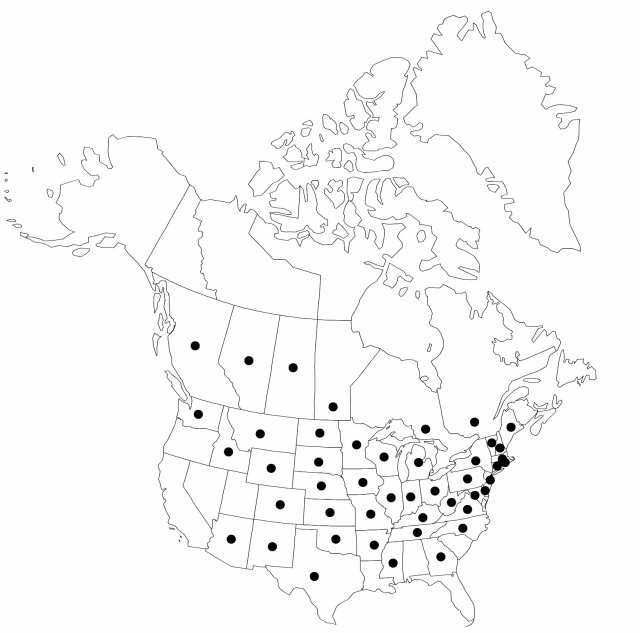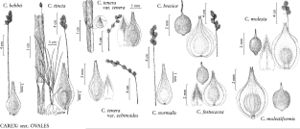Carex brevior
Amer. Midl. Naturalist 4: 235. 1915.
Plants densely cespitose; rhizomes sometimes short-prolonged, appearing elongate in old clumps. Culms 15–120 cm; vegetative culms few, inconspicuous, usually fewer than 15 leaves, not strikingly 3-ranked. Leaves: sheaths adaxially white-hyaline, summits U-shaped or sometimes prolonged to 2 mm beyond collar and rounded, smooth; distal ligules 2.2–3.5 mm; blades 3–5 per fertile culm, 12–30 cm × 1.5–3.5 mm. Inflorescences open, brown, (1.3–) 2.5–5 (–6.5) cm × 5–18 mm; proximal internode (3–) 6–13 (–23) mm; 2d internode 2–12 mm; proximal bracts scalelike or bristlelike, shorter than inflorescences. Spikes (3–) 4–7, 5–7 on larger culms, distant, distinct, ovoid to ellipsoid, 7–17 (–24) × 4–8 (–12) mm, base attenuate or rarely rounded, apex acute to rounded; terminal spike usually with conspicuous staminate base. Pistillate scales white-hyaline, tinged reddish-brown, usually with whitish, pale gold, or green midstripe, broadly lanceolate to narrowly ovate, 2.6–4.3 mm, as long as to 0.7–0.9 mm shorter than perignyium beaks, narrower than perigynia, margins thin, sometimes involute, apex mostly acute. Perigynia (10–) 15–40 (–45) per spike, ascending-spreading, green or reddish-brown, veinless or faintly and irregularly 1–5-veined adaxially, orbiculate or broadly ovate, planoconvex, (2.6–) 3.4–4.8 (–5.2) × (2–) 2.3–3.2 mm, 0.5–0.6 mm thick, 1.2–1.8 times as long as wide, nearly leathery, margin flat, including wing 0.3–0.8 mm wide, ciliate-serrulate at least distally, smooth; beak pale green or brown at tip, flat, ± ciliate-serrulate, abaxial suture with gold or reddish brown-hyaline margin, distance from beak tip to achene 1.5–2.4 mm. Achenes orbiculate to broadly ovate, 1.5–2.2 × 1.3–1.8 mm, 0.5–0.6 mm thick. 2n = 48, 52, 56, 60, 64, 68.
Phenology: Fruiting early–mid summer.
Habitat: Prairies, meadows, open woods, dry roadbanks, often in calcareous or neutral soils
Elevation: 0–2700 m
Distribution

Alta., B.C., Man., Ont., Que., Sask., Ariz., Ark., Colo., Conn., Del., D.C., Ga., Idaho, Ill., Ind., Iowa, Kans., Ky., Maine, Mass., Mich., Minn., Miss., Mo., Mont., Nebr., N.H., N.J., N.Mex., N.Y., N.C., N.Dak., Ohio, Okla., Pa., R.I., S.Dak., Tenn., Tex., Vt., Va., Wash., W.Va., Wis., Wyo., Mexico (Tamaulipas)
Discussion
Carex brevior seems to display an unusually broad, aneuploid chromosome series that does not readily correlated with any features of external morphology (P. E. Rothrock and A. A. Reznicek 1998). The chromosome variation may, however, have a geographic relationship. Among the plants observed, the lowest number came from northeast Texas while the highest number (n = 34) came from Manitoba (Á. Löve and D. Löve 1981b).
Records of Carex brevior from ruderal habitats east and south of its main range are likely introductions.
Selected References
None.
Lower Taxa
"shortened" is not a number."+timesaslongasinflorescences" is not declared as a valid unit of measurement for this property."not undefined" is not a number."short-prolonged" is not a number."narrower" is not a number.
